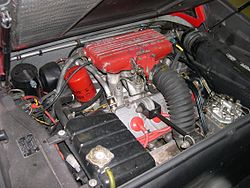
Dino was a marque best known for mid-engined, rear-drive sports cars produced by Ferrari from 1957 to 1976. The marque came into existence in late 1956 with a front-engined Formula Two racer powered by a brand new Dino V6 engine. The name Dino was used for some models with engines smaller than 12 cylinders, it was an attempt by the company to offer a relatively low-cost sports car. The Ferrari name remained reserved for its premium V12 and flat-12 models until 1976, when "Dino" was retired in favour of full Ferrari branding.
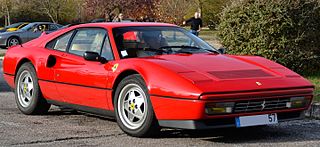
The Ferrari 328 GTB and GTS are mid-engine V8, two-seat sports cars created by Italian automobile manufacturer Ferrari. It was the successor to the Ferrari 308 GTB and GTS. While mechanically still based on the 308, modifications were made to the body, chassis, and engine, most notably an increase in engine displacement to 3.2 L for increased power and torque output. The 328 is still considered by some enthusiasts to be one of the most reliable and functional Ferraris; unlike other models, much of its maintenance can be performed without lowering the engine from the vehicle. In 1989, the 328 was succeeded by the 348.

The Lancia Thema is an executive car produced by the Italian automaker Lancia between 1984 and 1994, and one of four cars to share the Type Four platform alongside the Alfa Romeo 164, Fiat Croma and Saab 9000. The Thema was first shown in Turin Motor Show in 1984.
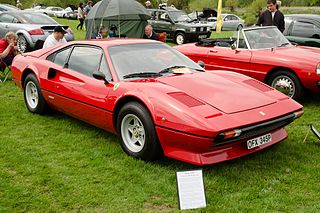
The Ferrari 308 GTB berlinetta and targa topped 308 GTS are V8 mid-engined, two-seater sports cars manufactured by the Italian company Ferrari from 1975 until 1985. The 308 replaced the Dino 246 GT and GTS in 1975 and was updated as the 328 GTB/GTS in 1985. The similar 208 GTB and GTS were equipped with a smaller, initially naturally aspirated and later turbocharged, two-litre engine, and were sold mainly in Italy.

The Ferrari Daytona is a two-seat grand tourer produced by Ferrari from 1968 to 1973. It was introduced at the Paris Auto Salon in 1968 to replace the 275 GTB/4, and featured the 275's Colombo V12 bored-out to 4,390 cc. It was offered in berlinetta and spyder forms. The car came in two variants: the 365 GTB/4 coupe, and the 365 GTS/4 convertible.

The Dino 308 GT4 and 208 GT4 were mid-engined V8 2+2 cars built by Ferrari. The Dino 308 GT4 was introduced in 1973 and supplemented by the 208 GT4 in 1975. The cars were sold with Dino badging until May 1976, when they received Ferrari badging. The GT4 was replaced by the Mondial 8 in 1980 after a production run of 2,826 308s and 840 208s.

The Ferrari Colombo Engine was a petrol fueled, water cooled, carburetted 60° V12 engine designed by Gioacchino Colombo and produced in numerous iterations by Italian automaker Ferrari between 1947 and 1988. The maker's first homegrown engine, its linear successor is the Lampredi V12, which it far outlived, the last Lampredi being made in 1959.

The Ferrari Lampredi engine was a naturally aspirated all aluminum 60° V12 engine produced between 1950 and 1959. Inline-4 and Inline-6 variants for racing were derived from it.
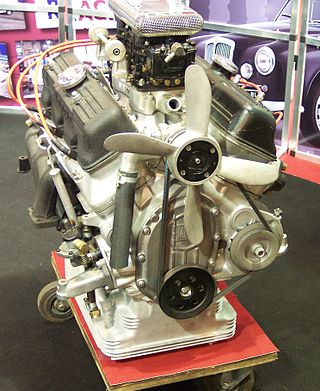
In 1950, Lancia introduced one of the world's first production V6 engines in the Lancia Aurelia. The engine was the work of Francesco De Virgilio and was developed to solve the vibration problems Lancia had experienced with its V4 engines. This was achieved by setting the vee angle to 60 degrees. It remained in production through 1970. Lancia used V6 engines in road and sports cars, the D20 had a 60 degree quad cam V6 2962 cc 217 bhp engine and the D24 3300 cc V6 engine.
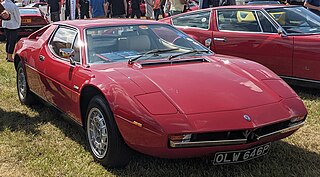
The Maserati Merak is a mid-engined 2+2 sports car produced by Maserati between 1972 and 1983. The Merak was closely related to the Maserati Bora, sharing part of its structure and body panels, but was powered by a 3.0 L V6 in place of the latter's 4.7 L V8. The extra cabin space gained by fitting a smaller and more compact powertrain was used to carve out a second row of seats—suitable for children or very small adults—making the Merak not just a less expensive alternative to the Bora but also a 2+2.

The Ferrari GTO is an exotic homologation of the Ferrari 308 GTB produced from 1984 until 1987 in Ferrari's Maranello factory, designated GT for Gran Turismo and O for Omologata.

The Alfa Romeo V6 engine is a 60° V6 engine made by Alfa Romeo from 1979 to 2005. It was developed in the early 1970s by Giuseppe Busso, and first used on the Alfa 6 with a displacement of 2.5 L (2,492 cc) and a SOHC 12-valve cylinder head. Later versions ranged from 1,996 to 3,179 cc and had DOHC 24-valve valvetrains. The original design had short pushrods for the exhaust valves in a design similar to earlier Lancia Fulvia engines. The first DOHC version was in the 1993 Alfa Romeo 164, with an aluminium alloy engine block and head with sodium filled exhaust valves.

The Dino 206 GT, 246 GT and 246 GTS are V6 mid-engined sports cars produced by Ferrari and sold under the Dino marque between 1967 and 1974.
The Ferrari flat-12 engine family is a series of flat-12 DOHC petrol engines produced by Ferrari from 1964 to 1996. The first racing Ferrari flat-12, the Mauro Forghieri-designed Tipo 207, was introduced in the Ferrari 1512 F1 car in 1964. Later flat-12 racing engines were used in Ferrari Formula One and sports racing cars from 1968 until 1980, including the 212 E Montagna, 312 B series, 312 PB and 312 T series. The roadgoing flat-12 engines were introduced with the 365 GT4 BB and were produced in various versions until the end of F512M production in 1996.
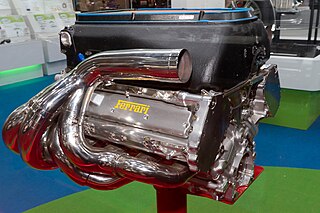
Ferrari has manufactured three naturally-aspirated V8 racing engines, designed for Formula One racing. First, the Tipo DS50 engine introduced in 1956; with the 2.5 L engine configuration. Second, the Tipo 205/B engine, introduced in 1964; with the 1.5 L engine configuration; and was designed by Franco Rocchi and Angelo Bellei. Then, a 42-year hiatus; until the FIA imposed a 2.4 L engine V8 configuration for all Formula One teams in 2006, with Ferrari introducing their Tipo 056; designed by Gilles Simon.
Ferrari made four naturally-aspirated V6 racing engines designed for Formula One; between 1958 and 1966. The Formula One regulations for 1954–1960 limited naturally aspirated engines to 2500 cc, and for the 1958 season, there was a change from alcohol fuels to avgas. The 246 F1 used a 2,417.34 cc Dino V6 engine with a 65° angle between the cylinder banks. The power output was 280 PS at 8500 rpm. Bore X Stroke: 85 mm × 71 mm This was the first use of a V6 engine in a Formula One car, but otherwise the 246 F1 was a conventional front-engine design. The Ferrari 246 F1 was good enough to win a World Championship for Mike Hawthorn and a second place in the Constructors' Championship for Ferrari.
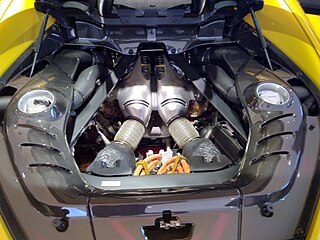
The Ferrari Tipo F163 engine is a 3.0-liter, 120°, twin-turbocharged V-6 internal combustion piston engine, made by Ferrari. It is Ferrari's first turbocharged 6-cylinder engine designed and developed for road car use.

